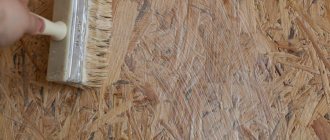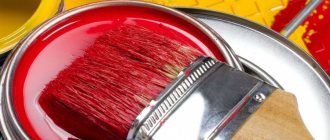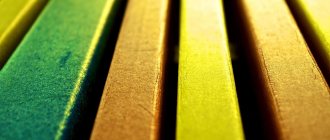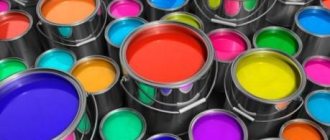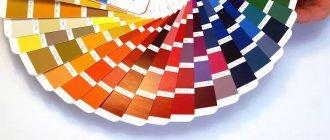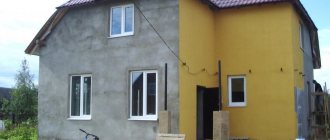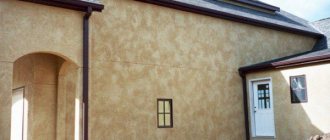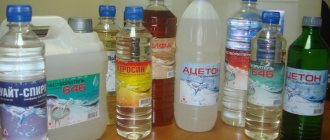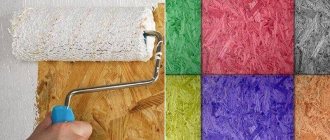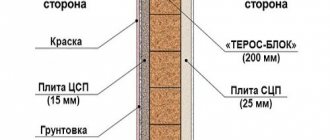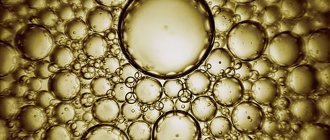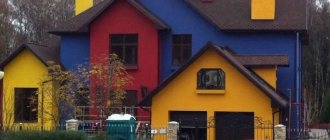Felix
3379 0 0
Felix May 15, 2018Specialization: philological education. 20 years of experience as a builder. Of these, for the last 15 years he led a team as a foreman. I know everything about construction - from design and zero cycle to interior design. Hobbies: Vocals, psychology, quail breeding.
Acrylate coatings are ideal for painting facades.
Greetings, my dear readers!
It is no secret that there is such a problem as choosing paint for finishing the facade of a building. After all, some types of paints and varnishes are excluded immediately; they are suitable only for interior work.
Manufacturers now produce quite a few types of paints and varnishes suitable for outdoor use. Among them are acrylate paints. They will be discussed in this article.
The characteristics of paint used under very unfavorable conditions must be special. First of all, it must withstand all types of atmospheric and mechanical influences.
Acrylic paint - features, scope and advantages
Acrylic paint has increased elasticity, so it is recommended to use it for painting products that are subject to linear expansion due to changes in humidity or temperature changes. They are used for finishing work and as decoration.
The positive aspects of using these mixtures include the absence of odor and low toxicity. This means that people who are prone to allergic reactions or have upper respiratory tract diseases can work with them. The complete safety of such compositions allows their use indoors, including in the bedroom.
The paints are resistant to increased release of moisture and steam condensate. They can be used to paint walls, partitions in bathrooms, toilets, and kitchens. There are special compositions for facade work. They do not fade or change color, as they are resistant to ultraviolet radiation.
Disadvantages of acrylic paint:
- at low temperatures the mixture freezes, since it contains water, and after defrosting, the paint loses its properties;
- strength and decorative qualities are achieved only after a month;
- Snow-white paints are most often sold in finished form; to obtain the desired shade, it is necessary to further dilute it with a special color.
The use of glossy compounds is not recommended for uneven surfaces. This will only highlight all the shortcomings and errors. Matte mixtures, on the contrary, will help to visually hide all defects and irregularities. Before application, the old coating is cleaned and dust is removed. If unevenness is detected, the surface must be sanded and then primed. This will help prevent rotting, mold, and mildew.
Main operating parameters
The main operational parameters include color, appearance of the surface after application, the proportion of resin content, and additional components.
Main paint properties and technical characteristics:
- after application and hardening, a homogeneous film with a smooth surface is formed;
- the selected shade will be similar to the sample in the catalog;
- slightly alkaline composition;
- titanium dioxide is added to the composition;
- drying speed in warm weather – 60 minutes;
- After complete drying, the surface of the walls and ceilings can be washed.
The properties of the paint include its resistance to frost. It refers to the number of freezing cycles that the coating can withstand under standard conditions. Additional parameters are drying speed, resistance to light and mechanical damage.
Properties of acrylic enamel
Enamel creates a varnish film that does not allow air to pass through. Therefore, this type of paint is considered not the best option for application to mineral or wooden surfaces. Any coating - concrete, wood, brick - must breathe. Otherwise, condensation will accumulate under the decorative coating, causing peeling or cracking of the top layer.
Good quality enamel is recommended for processing metal surfaces. Metal requires additional protection from moisture and air.
This, in turn, prevents the formation of corrosion and prevents products from deteriorating, increasing their service life. This type of mixture has an affordable price, is easy to apply, and evenly distributed over the surface.
Sprayers, brushes, and cans can be used as auxiliary tools. The color range of finished enamels is wide. The composition does not have high resistance to ultraviolet rays and fades quickly.
Dried enamel hardens and is inelastic, so when there are temperature changes or constant humidity, it peels off and cracks. If it is necessary to paint the product after 1-2 years, it is necessary to clean off the old coatings, degrease them with solvents, and only then paint them again.
Operating procedure
The application of acrylate paints is carried out according to a specific algorithm and subject to a number of conditions. The last factor is considered important, since without following the manufacturer’s recommendations, the dried layer will not acquire the properties described above.
Required tools and materials
The volume of paint and varnish materials that need to be purchased depends both on the type of composition and on the area of the work being carried out. On average, surface treatment requires 300-400 milliliters of paint per 1 m2. More precise parameters are indicated on the container with the material.
Additionally, it is recommended to purchase a primer and antiseptic. The latter will be required in cases where wooden structures are painted. The antiseptic will protect the surface from fungus and mold.
Also, to carry out such work you will need a set of brushes and rollers of different sizes. If the ceiling and high walls are being painted, a stepladder is needed. And if you plan to treat large areas, it is recommended to purchase (rent) a paint sprayer.
Surface preparation
Before painting it is necessary;
- clean the surface from old paints;
- remove oily stains using acetone or other similar compounds;
- remove dust and other contaminants;
- level the surface.
See also
How to dye a down jacket a different color at home
Upon completion of the described actions, you need to prime the surface and apply an antiseptic.
Preparation of the solution
The coloring composition is diluted according to the manufacturer's recommendations. It is impossible to give general advice on how to mix correctly. This is due to the fact that the type of paint is selected taking into account the characteristics of the work being carried out. In some cases, the initial composition must be mixed not only with the pigment, but also with water, which will provide the desired viscosity.
Also, the procedure for preparing acrylate paint depends on the type of material. For wood processing, compounds are used that are not suitable for concrete, and so on.
Coloring
Acrylate paints are applied according to the same scheme as is used when working with other similar materials. It is recommended to work with this composition at temperatures from +5 to +20 degrees and in conditions of average humidity (at high humidity, specialized material is used).
After mixing, the solution must be applied immediately. If you plan to take a break from work, the containers must be closed, since acrylate compounds dry quickly. It is recommended to apply the paint in 3-4 layers, waiting 1-2 hours each time.
Completion
At the end of the work, it is recommended to inspect the painted walls (ceiling, floor, etc.) and, if found, remove any particles of dirt or lint from the brushes (rollers) by applying another layer of material to these places. If necessary, after drying, the surface can be re-treated. Thanks to this, you can make the shade more saturated.
What is the difference between acrylic compositions and what is better to choose - enamel or paint
The difference between paint and enamel is vapor permeability and moisture resistance. As an additional coating, a thin layer of varnish can be applied to the enamel; it does not adhere well to the water-dispersion base and does not affect its durability. Therefore, acrylic paint is better suited for exterior work, and metal fences, doors, and cars can be coated with enamel.
In terms of weather resistance and durability, acrylic materials are clearly superior to alkyd materials, which makes them the best for outdoor use.
The advantages of alkyd impregnations for exterior use are explained not by the protective properties of the material, but by the depth of penetration into the protected wood. When working on wood, it is allowed to use any type of paint.
An acrylic base is best suited for application to leather, paper, and fabric. This is possible due to the high elasticity and breathability of the composition.
Advantages of using enamel:
- durability of glossy surface;
- brighter and more saturated colors;
- wear resistance;
- creates a protective film;
- When processing metal, it provides additional protection against corrosion.
Positive aspects of using acrylic paint:
- allows air to pass through when processing any surfaces;
- resistance to ultraviolet radiation and temperature changes;
- transparency and colorlessness;
- environmental friendliness;
- can be sanded and polished.
The composition of acrylic enamel includes alkyd varnish, coloring pigments, and solvent. Depending on the manufacturer, fire-fighting, antifungal additives, and antiseptics are added to the enamel. After application, drying time can last from several days to several weeks. In addition, the specific smell requires additional ventilation of the room.
Painting wood: what is important to consider?
When painting wooden surfaces, it must be taken into account that wood is a special material. This is a natural, organic material, which is characterized by such disadvantages as the possibility of rotting, mold, and other harmful microorganisms. In addition, the material has a specific structure (depending on the type of wood), which I would like to preserve without having a destructive effect on it.
Painting is a means of protecting your timber home, increasing its durability and improving its appearance for decades to come.
In this regard, we can add new items to the list of requirements for paints for exterior woodwork.
Qualities required for facade finishing
The paint coating must be frost-resistant.
A coloring composition for external work must have a set of certain qualities. First of all, this:
| Photo | Description |
| Resistance to extreme temperatures |
The paint must withstand freezing temperatures well in the cold season (November-March) and heat in the summer.
The coating should not crack or fade from direct sunlight.
They are typical in the off-season and can reach 20 °C during the day.
This is increased humidity and dryness of the air, precipitation, etc.
Paint for external woodwork should have additional properties:
- It should contain antiseptics . They will protect the base from the proliferation of harmful microorganisms.
- Finishing should preserve the structure of the wood and its natural qualities as much as possible..
- Wood breathes, providing a healthy microclimate inside the house . Therefore, the paint must be air- and vapor-permeable so as not to interfere with it.
Characteristics of acrylate dyes
Acrylate paint has all of the qualities listed above. In addition, she:
- easy to apply;
- dries quickly;
- has good adhesion to all types of substrates;
- spent sparingly;
- wears out slowly;
- serves for a long time.
Definition
Water-soluble paint and varnish products are a combination of precisely selected proportions of chemically active components. The components improve each other’s properties, increase important characteristics, and reduce the incidence of undesirable effects.
Main components:
- The polymer is a binding base, improves the adhesion of the solution to the surface being painted, extends its service life, and resists negative factors.
- Pigment is a powder suspension that colors the base. Added by manufacturer, sold separately.
- A filler with a structure similar to pigment enhances paint durability and gives the surface a matte, glossy finish.
- Solvent is the basis of the mixture, added in the required quantity by the manufacturer, it increases or decreases the viscosity of substances.
- Additives help improve performance and create new properties.
The division into groups is made by choosing a similar binder polymer:
- polyvinyl acetate;
- butadiene styrene;
- acrylic silicone;
- acrylic;
- rubber acrylate-latex.
Advantages
There are many characteristics that attract buyers. There are insignificant differences between identical solutions from different manufacturers, so it is recommended that you review the properties of interest in the instructions before purchasing.
Main advantages:
- Easy to apply using any known method, covers the base well.
- No sharp, unpleasant odor. It is allowed to paint children's rooms.
- Good quality coating, long service life.
- Environmentally friendly basis, safety, no chemical impurities that negatively affect health.
- Available in white, pigments are used to add shades.
- Economical - low cost when compared with other varieties.
- Availability – prices are relatively low, good quality.
- Dries quickly, re-painting is carried out after 6 hours.
- Moisture and ultraviolet radiation do not have a negative effect.
Flaws
There are several criteria that repel buyers:
- Increased requirements for the base - ideal evenness, absence of debris, high adhesive qualities. A thin layer does not hide unevenness, defects, or chips of the previous finish.
- Surface cracking occurs under the influence of low temperatures, temperature changes, and drafts.
- Harmless composition - an advantage and a disadvantage. The coloring solution is harmless to humans, microorganisms, bacteria, fungi, and pests. It is recommended to treat the base with antiseptic substances before painting.
What is the difference between acrylate paints and acrylic paints?
The binder in acrylic paints consists 100% of the polymer of the same name.
In paints called acrylics, the binders are acrylic and methacrylic. These polymers are derived substances from ethereal elements.
A film-forming substance consisting of 100% acrylic is optimal for facade coatings:
- It makes it possible to create a weather-resistant, elastic, vapor-permeable finish.
- This coating is wear-resistant and durable.
- The polymer film is resistant to ultraviolet radiation and temperature changes.
Acrylate paints contain a copolymer, for example silicone.
But paint on pure acrylic, for all its advantages, has one significant drawback - it is very expensive. Therefore, manufacturers often use binders consisting of a mixture of acrylic and other, cheaper polymers. Such compositions are called acrylate-copolymer or simply acrylate.
Most often, the following are used as an additional binder:
- butadiene;
- styrene;
- vinylpyridine;
- latex;
- polyvinyl chloride;
- polyurethane;
- polyvinyl acetate, etc.
Using these copolymers, it is possible to improve the characteristics of paintwork materials. At the same time, the cost of paint drops by almost 2 times.
Use of material
Water-based acrylate dyes can be applied to almost all types of facades:
- brick;
- concrete;
- wooden;
- metal;
- plastered.
Rules for using the material:
- Facade paints on acrylic are applied to a previously cleaned and primed surface.
- The coating should be applied in 2–3 layers.
- You can work at an air temperature of at least +5 °C and moderate humidity.
- The paint should not come into contact with the user's eyes. Therefore, when finishing the facade you should use personal protective equipment.
Containers with acrylate paint must be stored at a temperature of at least +5 °C. The room should be dry. Buckets should not be exposed to direct sunlight. The guaranteed shelf life of the material is 12 months.
The best manufacturers and brands of acrylate coatings
Here are the brands of acrylate paints that can be recommended for work:
| Photo | Paint brand |
| Hybrid-Silikat/Fassadenfarbe This is an acrylic-silicate-silicone paint, which contains ceramic additives. It is produced by the Russian-German joint venture Tex-Color. The paint is characterized by vapor permeability, durability, resistance to weathering and ultraviolet radiation. | |
| ACE Contractor-Pro/Flat Latex-Wall Paint Universal paint based on acrylic and latex. Suitable for wooden, plaster, brick, concrete and metal substrates. The material is produced by the American company ACE Hardware Corporation. | |
| Pika-Teho Matte composition based on acrylic and latex, containing fir oil. Used for painting external wooden surfaces. This paint is produced by the famous Finnish company Tikkurila. | |
| Dali-LA Facade paint based on acrylic and latex. Super-elastic and weather-resistant coating designed for wooden substrates. Contains antiseptic additives. This composition is produced by the Russian company Rogneda. | |
| Lignovit Color The copolymer in this paint is vinyl. Thanks to this, the composition can be used for both internal and external work. High-quality paint forms a coating on the base that can withstand any climatic conditions. The finish is elastic, so it will not crack over time. This paint and varnish material is produced by the Austrian company Adler. | |
| Expert Fassadenweiss The additional binder is polyurethane. This paint is environmentally friendly, resistant to atmospheric, impact and mechanical influences. The material is produced by the German company Alpina. | |
| Perfect Akrylatfarg This is a semi-matte acrylic latex paint. This composition is universal. It can be used for finishing wooden, metal, concrete and brick facades. This paint and varnish material is produced by the Swedish company Beckers. | |
| Siloksan/Facade The binders of this paint are silicone and acrylic. It is sealed with organic solvents. For use on mineral substrates only. The composition is produced by the Finnish company Teknos. |
Conclusion
Acrylate paints are ideal for painting all types of facades. They are weatherproof, wear-resistant, durable, impact-resistant and resistant to mechanical stress. Due to the presence of copolymers, they are not as expensive as acrylic counterparts.
If you have questions, ask them in the comments. Therefore, I say goodbye and success to you in your endeavors.
Before starting repairs, users have many questions. Many people cannot decide which paint to use. The most popular are latex and acrylic compositions. In the construction market, they are often confused, so it can be difficult for an ordinary buyer to make a choice in favor of a specific product.
Compound
The latex mixture consists of concentrated pigment, various dispersions, preservatives, solvent and water. Often, substances are added to the composition of such materials that make the characteristics of the resulting coating much better. As for acrylic paint, it usually contains no impurities, but contains concentrated elements.
Types of paints
There are many different colors. However, latex and acrylic options are considered the most common.
Acrylic options were not always popular, as they were expensive. However, today they are in demand. In their performance characteristics and significant parameters, these paints outperformed other compositions. They are very beneficial to use. In addition, they are used for both exterior and interior decoration. Moreover, they are very economical.
There are also special acrylate paints. Hearing this name, many consumers wonder what the difference is between acrylic and acrylate mixtures. There are no big differences between them. Acrylic paint has the same composition as acrylate paint. It's all about marketing strategies - it's better to sell the material under different names, creating the illusion of diversity.
Latex paint is used for interior and exterior decoration. To prevent the appearance of mold, a certain substance is included in it. There are several varieties of popular latex paints. For example, to create a beautiful relief on the bases, texture compounds are used.
Let's take a closer look at the popular varieties of acrylic and latex paints.
Polyvinyl acetate
Polyvinyl acetate paint is one of the types of latex compounds. In everyday life it is referred to as “water-based emulsion” or water-dispersion paint. It is based on PVA.
Decoration
The acrylate composition can be applied using a paint sprayer or a paint roller. In the second case, brushes of different widths are used to paint joints, corners and hard-to-reach places. When this stage of work is completed, you can saturate the roller coat with paint and begin applying the coating.
You should start from the top, carefully painting square by square. To avoid drips on the wall or ceiling, the material must be applied in a thin layer.
When the surface is completely covered, you need to wait for it to dry, and only then apply a second coat, which is usually enough to get a good result. The color is saturated, the paint lies evenly, the façade or interior looks flawless!
The disadvantages of acrylate paints could be their relatively high cost, but it is justified by the excellent quality of the materials, their high protective properties and decorative properties.
Acrylic paint has high performance and technological characteristics; it is made on the basis of polymers of acrylic and methacrylic acids and their derivatives: esters, amides, nitriles and others.
Differences
Acrylic and latex mixtures are similar in many ways. However, the acrylic composition differs from mixed latex options in its content.
- in latex paint the binder is styrene butadiene;
- in acrylic - acrylic latex.
They are synthetic resins. It is worth considering one more fact - natural latex derived from rubber trees is not added to these paints.
Very often, such paint and varnish coatings are not distinguished because they have similar operational and physical characteristics. These finishing materials form a protective elastic film when dry. But acrylic has surpassed latex in terms of the strength characteristics of the final coating, because it is more moisture- and wear-resistant.
How to choose?
To choose a paint, you need to choose the right color and understand all the characteristics it has. Particular attention should be paid to the degree of gloss - there are several of them.
The highest degree is rarely purchased, because it affects the specularity of the reflections of the planes. This effect often adversely affects the perception of the interior as a whole. Thus, matte paint has a reputation as the most common.
No less important parameters are moisture resistance and wear resistance. The first is determined by the number of abrasion cycles, which is usually indicated on the packaging. Wet abrasion cycles mean the paint is moisture resistant, while dry abrasion cycles mean the paint is not moisture resistant.
You should also pay attention to such characteristics as thixotropy and hiding power. The first is responsible for the occurrence of leaks. Thixotropy affects how quickly the paint thickens.
With prolonged thickening, streaks appear. Covering power shows the formation of a film without bald spots - consumption for normal coverage.
